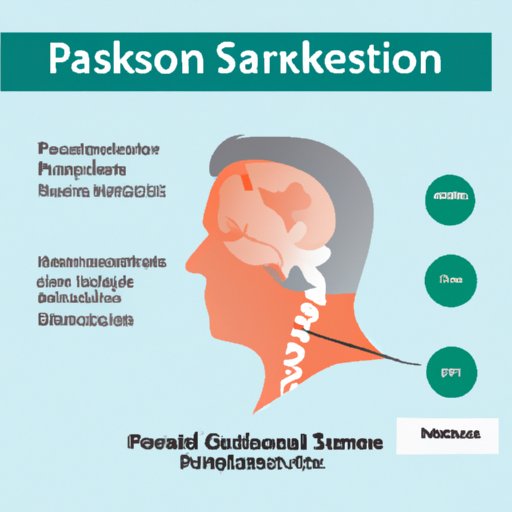
Introduction
Parkinson’s disease is a chronic, degenerative nervous system disorder. Many people associate Parkinson’s disease with tremors, but the disease actually affects all aspects of movement, including walking, speaking, and daily tasks. There is no known cure for Parkinson’s disease, but medication and therapy can help manage symptoms and improve quality of life.
As a life-threatening disease, Parkinson’s disease has an alarming mortality rate. While there’s no one-size-fits-all answer to the mortality rates associated with Parkinson’s disease, it’s worth exploring the factors that can contribute to greater risks. In this article, we will delve into the nuances of the disease and discuss the factors that can worsen its impact.
Exploring the Mortality Rates of Parkinson’s Disease: Can it Really Be Fatal?
According to a study published in the Journal of Parkinson’s Disease, Parkinson’s disease patients are up to four times more likely to die than the general population. In other words, being diagnosed with Parkinson’s disease increases your risk of dying prematurely. Understanding mortality rates is essential for understanding the disease. Parkinson’s disease mortality rates can vary widely based on factors like a patient’s age, sex, and overall health.
When compared to other diseases, Parkinson’s disease is notably less fatal than conditions like heart disease and cancer. However, the disease is still serious and can lead to complications like pneumonia and other infections; statistically, Parkinson’s disease is linked to a higher risk of death than many other diseases.
Needless to say, discussing the mortality rates of Parkinson’s disease is important. As the disease’s prevalence continues to grow, there is a greater need to better understand the risks and challenges.
When Parkinson’s Disease Attacks: Understanding the Severity of Symptoms and their Effects on Death Rates
Parkinson’s disease is characterized by a range of symptoms that can vary from patient to patient. Some people with the disease experience only mild tremors and mobility issues, while others may experience more severe symptoms like difficulty chewing and swallowing, loss of bladder control, and even loss of cognitive function.
Unfortunately, the severity of symptoms is often a strong indicator of mortality rates with Parkinson’s disease. People with more advanced symptoms tend to be at higher risk of death than those with milder symptoms.
Common causes of death for Parkinson’s disease patients include cardiovascular disease, pneumonia, and other respiratory infections. Patients with Parkinson’s disease may also be more susceptible to falls and accidents due to balance issues and falls caused by impaired mobility.
Breaking Down the Statistics: How Parkinson’s Disease Increases Your Chances of Mortality
Parkinson’s disease can impact mortality risk in a range of different ways. Age is one of the biggest factors, as mortality rates are higher in older people. Additionally, Parkinson’s disease has been linked to higher rates of depression and anxiety, which can also impact mortality rates.
Finally, Parkinson’s disease can lead to a range of other health complications that can increase the risk of death. These can include everything from insomnia to cardiomyopathy and other disorders of the heart. Patients with Parkinson’s disease are also more susceptible to falls and accidents due to compromised mobility, which can further increase their risk of death.
In terms of the differences seen between early and later stages of Parkinson’s disease, the risk of mortality is notably higher for those with more advanced disease. Late-stage Parkinson’s disease patients have a 50% higher risk of mortality than those in earlier stages of the disease.
Beyond the Tremors: Debunking Misconceptions and Explaining How Parkinson’s Disease Can Lead to Death
One of the biggest misconceptions about Parkinson’s disease is that it only affects movement. However, the disease can also lead to a range of other non-motor symptoms, including depression, anxiety, insomnia, and cognitive impairment. These symptoms can pose significant risks to Parkinson’s disease patients and contribute to higher mortality rates.
Another commonly overlooked factor is the importance of early detection and treatment of non-motor symptoms. By addressing these symptoms, doctors may be able to slow disease progression and improve overall prognosis.
From Diagnosis to Death: The Progression of Parkinson’s Disease and its Impact on Mortality
Parkinson’s disease typically progresses through five stages. In the early stages, a patient may experience mild tremors and stiffness and experience only mild disruptions to their daily routine. As the disease progresses, they may experience more severe motor and non-motor symptoms and complications.
The middle stages are characterized by significant motor and non-motor symptoms, and patients may require assistance with daily activities. The late stages are the most severe, with symptoms that can significantly impact daily life and health. Patients in this stage tend to have a significantly increased mortality rate as they are more likely to experience dangerous complications.
Living with the Risk of Death: How Those with Parkinson’s Disease Manage Their Illness
There are a number of different treatment options available for Parkinson’s disease, including medication, physical therapy, and even surgery in some cases. While these treatments can help manage the disease’s symptoms and improve overall prognosis, they are not a cure.
Parkinson’s disease can be an emotionally challenging condition, and those who live with it face a significant risk of death. Many patients work to manage their illness through exercise, dietary changes, and other lifestyle modifications. Ultimately, living with Parkinson’s disease means accepting the heightened risk of death and doing everything possible to manage its impact.
Conclusion
Parkinson’s disease is a chronic, progressive disease that impacts movement and causes a range of symptoms that can significantly impact daily life and health. Understanding mortality rates and risk factors for the disease is essential for doctors and patients alike. Parkinson’s disease increases a patient’s risk of death, particularly when the disease progresses. However, ongoing research into the disease brings hope for better treatments and improved prognosis. For now, those with Parkinson’s disease can manage their illness through lifestyle modifications and working with their healthcare team to find effective treatments.





